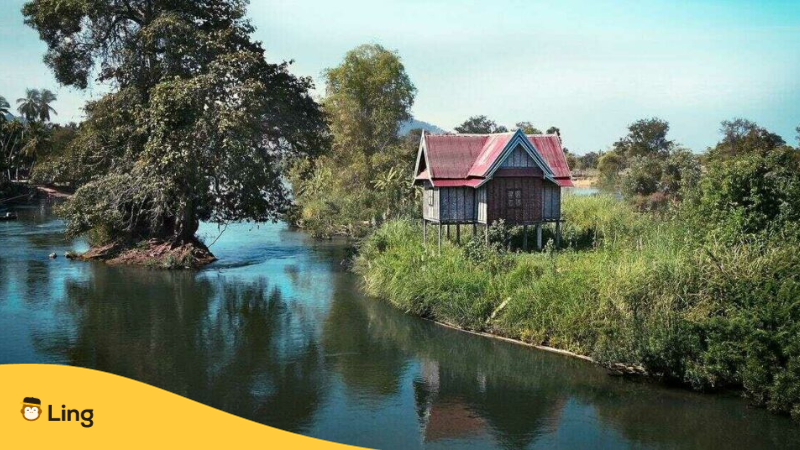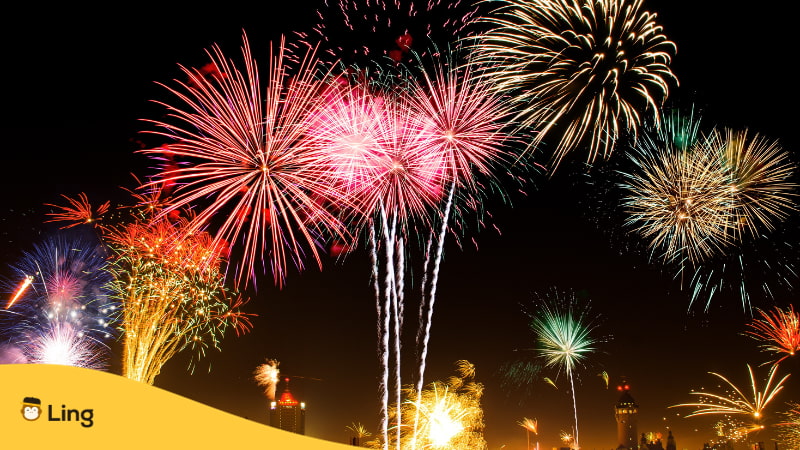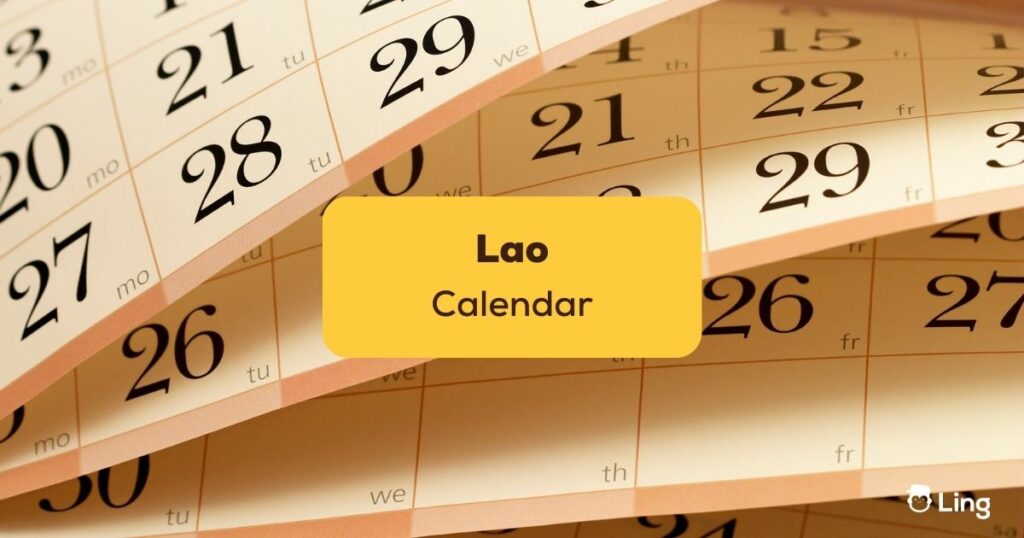What are the most important events in your life? Do you remember what events made an impact on your language-learning journey? If you’re interested in learning Lao, then you should check out these essential dates in the Lao calendar.
The Lao calendar is jampacked with events. There’s everything from Pathet Lao Day on January 6 to Boun Pi Mai starting on April 14 (the Lao New Year), when the whole country goes into a frenzy. Let’s have a look at the list.
What Is The Lao Calendar?
Let’s first get to know the Lao calendar. Yes, it tells days and months, but it’s also a special way Laos people track time, filled with stories and traditions from long ago. Here’s a closer look at this unique calendar.
Where It All Began
The Lao calendar, called “Patithin (ປະຕິທິນ)” by locals, mostly follows the moon’s phases. It started from old Buddhist ways and was touched by the Indian Saka calendar, brought to Laos by early Buddhist teachers.
But, to make sure festivals happen in the right seasons, they mixed in some parts of the sun calendar. So, it’s a mix of both moon and sun calendars now.
Role In Daily Life
Many people in Laos use the Gregorian calendar we all know for everyday stuff, like work or school. But for big festivals and religious days, the Lao calendar is the star.
For example, the Lao New Year, called “Boun Pi Mai,” is set using this calendar. It makes sure the celebration matches the end of the dry season.
Symbol Of Lao Identity
The Lao calendar shows what’s important to Laos people. Every event, like Boun Awk Phansa (when Buddhist Lent ends) or Boun Khao Padap Din (a day to remember loved ones who have passed away), tells a story about Laos life, beliefs, and what the community holds dear.
What Are The Important Events In The Lao Calendar?
| Day | Event | Description |
|---|---|---|
| January 1 | New Year’s Day | Celebrates the beginning of the new year. |
| January 1 | Pathet Lao Day | Commemorates the founding of the Lao People’s Revolutionary Party. |
| January 6 | Army Day | Honors the Lao People’s Army. |
| February-March | Boun Khao Chi | Buddhist festival commemorating the past life of the Buddha. |
| January 20 | Women’s Day | Observance of International Women’s Day. |
| March 8 | People’s Party Day | Celebrates the founding of the Lao People’s Revolutionary Party. |
| Late March | Boun Pha Vet | Buddhist festival commemorating the past life of the Buddha. |
| April 14-16 | Boun Pi Mai | Lao New Year celebration. |
| March 22 | Labour Day | Observance of International Labour Day. |
| Mid-September | Rocket Festival | Encourages the heavens to send rain for the rice planting season. |
| Late May | Boun Visakha Bousa | Buddhist holiday commemorating the birth, enlightenment, and death of the Buddha. |
| May 1 | Children’s Day | Day dedicated to children. |
| Mid-July | Boun Khao Pansa | Marks the beginning of Buddhist Lent. |
| June 1 | Lao Issara | Commemorates the introduction of the nationalist and separatist movement, Lao Issara, in 1945. |
| August-Sept | Haw Khao Padap Din | A day to remember and make merit for deceased relatives. |
| Mid Sept | Boun Khao Salak | A merit-making ceremony for the deceased. |
| August 13 | Liberation Day | Commemorates the day Laos was liberated from France in 1945. |
| Mid October | Bun Ork Phansa | Marks the end of Buddhist Lent. |
| Early November | That Luang Festival | A Buddhist festival held at the That Luang stupa in Vientiane. |
| November-December | Hmong New Year | Celebrated by the Hmong ethnic group in Laos. |
| October 12 | Lao National Day | Celebrates the establishment of the Lao People’s Democratic Republic. |
What Is The Pathet Lao Day?
In theory, this blog about the Lao calendar could go on endlessly because there’s so much nuance in the different days that are celebrated in Laos. The people of Laos do well with their public holiday allowance (13 in total as of 2023), but it’s nothing compared to bordering Cambodia, which celebrates 21. Thailand is not far behind with 15.
First things first, Pathet Lao Day is celebrated annually on January 6. The Pathet Lao came to power after the Vietnam War, and the communists fought for a free Laos.
It is hugely symbolic for the Lao People’s Democratic Republic. It is seen as a day to celebrate the time when the Lao people rose up and finally shook off the colonial shackles. (Note: Army Day on January 20 is closely related).

Boun Khao Chi
This religious festival is another important celebration in honor of the Buddha. People carry candles and circle their local temples. The festival takes place during the third full moon of the lunar calendar. An offering of food is made to the monks called Makhaboucha.
Boun Visakha Bousa
This religious festival celebrates the birth, enlightenment, and death of the Lord Buddha. It always happens on the 15th day of the 6th lunar month. Because of the associated pageantry, it is a great time to visit Laos(Luang Prabang especially).
Haw Khao Padap Din
This is a festival to mark Buddhist Lent. It is celebrated on the 15th day of the 9th month.
In Lao, ‘Haw’ means wrapped in small packs. What is wrapped in small packs is sticky rice and sweet coconut milk.
Lao religion is peculiar because, as well as being Buddhist, it also has an element of Animism. Haw Khao Padap Din is also a time to pay respect to Maethaulanii, the earth god.
During the festival, people make offerings such as cigarettes and sweet treats at the foot of trees. This happens all in darkness because it is the time when spirits are supposed to come out.
Boun Ork Phansa
This festival marks the end of Buddhist Lent (3 months long) and the rainy season. It marks the end of the period when monks must remain in their temples.
After Boun Ork Phansa, festivals began to take place again. A sight that is well worth seeing is the Nam Khan River, lit up by small boats made of banana leaves and housing a candle.
That Luang
That Luang is actually the name of a famous stupa that Lao Theravada Buddhists believe contains a relic from the Buddha.
That Luang is over 500 years old and has been destroyed and rebuilt several times. People gather in Vientiane for the three-day festival at Wat Si Muang before moving to That Luang.
Like many things related to Lao festivals, offerings are made to monks so people can hopefully gain future prosperity. Again, worshippers circle the stupa three times while holding candles.

Hmong New Year
This is often overlooked in the calendar because the Hmong are a minority. It shares many similarities with the Lao New Year and centers heavily around honoring the spirits of ancestors. It ranges from 3 days to a week long.
Offerings are made to the god of wealth and prosperity. Popular food includes boiled chicken, Hmong Larb, and papaya salad. Ironically, many Hmong now live outside Laos, so many of the world’s biggest New Year celebrations take place in America.
Learn The Lao Language With The Ling App!
There you have it. Those are all the festivals in the Lao calendar. Laos holidays are some of the most colorful and energetic in the world, which is why you should book a holiday there. If you want to learn more about the Lao language and its culture, you must check out the Ling app.
Ling has developed Lao language courses that are excellent for beginners and advanced learners alike. Start with the basics, like introducing yourself, and then move on to language about space travel once you find your footing!
There are 15-minute bite-sized lessons that will get your day off to a winning start. The app also has a chatbot function that allows you to practice speaking with an advanced AI algorithm.
Don’t forget to watch our Lao blog, which is updated almost daily.
Have you downloaded the Ling app for your phone yet? If not, get it now from the Play Store and the App Store and discover the amazing Lao language. Don’t be shy to leave a comment below. Until next time!
Updated by: Jefbeck




































